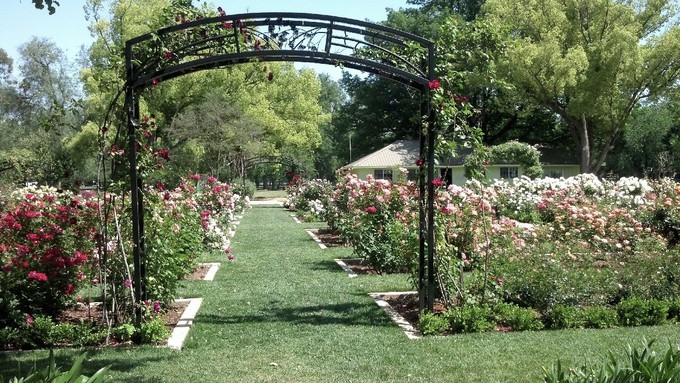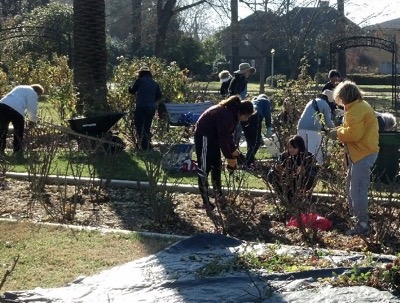
Volunteers needed to help landmark site while learning about rose care

This is the McKinley Park Rose Garden in its full blooming glory. Achieving this in 2023 is the goal of the January Prune-a-thon. Debbie Arrington
It’s back! In January, rose lovers and gardeners of all ages will come together for Prune-a-thon – a community effort to help the McKinley Memorial Rose Garden.
In years past, volunteers pruned the garden’s entire collection of 1,200-plus roses in one day. The upcoming 2023 Prune-a-thon will stretch over two Saturdays – Jan. 7 and 14. Each pruning session will run from 9 a.m. to noon with a light lunch available for participants.
Experienced rosarians from the Sacramento Rose Society and Sacramento parks staff will supervise volunteers.
Registration and parking are free. No experience is necessary, although volunteers under age 18 must have a parent’s or guardian’s signature to participate. Tools and instruction will be provided. Bring gloves and, if possible, bypass pruners.

The Prune-a-thon is a great opportunity to learn about roses or reinvigorate pruning skills. It’s also a wonderful chance to show this historic rose garden some love.
This month, the City of Sacramento Parks and Recreation Department took over management of the rose garden as well as Clunie Community Center and the Shepard Garden and Arts Center from Friends of East Sacramento. In addition to tackling pruning (the biggest chore in any rose garden), the Prune-a-thon will serve as a recruiting event for year-round rose garden volunteers.
Prune-a-thon participants should dress warmly. Closed-toe shoes are required. Water will be provided.
For details and to register in advance via QR code: https://bit.ly/3HQU9JM
Want to learn more about rose care? Here are a few of Debbie's previous posts:
December rose care: Start pruning now
Grow your own vase-worthy roses
Comments
0 comments have been posted.Sacramento Digs Gardening to your inbox.
Food in My Back Yard Series
May 6: Maintain soil moisture with mulch for garden success
April 29: What's (already) wrong with my tomato plants?
April 22: Should you stock up on fertilizer? (Yes!)
April 15: Grow culinary herbs in containers
April 8: When to plant summer vegetables
April 1: Don't be fooled by these garden myths
March 25: Fertilizer tips: How to 'feed' your vegetables for healthy growth
March 18: Time to give vegetable seedlings some more space
March 11: Ways to win the fight against weeds
March 4: Potatoes from the garden
Feb. 25: Plant a fruit tree now -- for later
Feb. 18: How to squeeze more food into less space
Feb. 11: When to plant? Consider staggering your transplants
Feb. 4: Starting in seed starting
Sites We Like
Garden Checklist for week of May 11
Make the most of the lower temperatures early in the week. We’ll be back in the 80s by Thursday.
* Plant, plant, plant! It’s prime planting season in the Sacramento area. Time to set out those tomato transplants along with peppers and eggplants. Pinch off any flowers on new transplants to make them concentrate on establishing roots instead of setting premature fruit.
* Direct-seed melons, cucumbers, summer squash, corn, radishes, pumpkins and annual herbs such as basil.
* Harvest cabbage, lettuce, peas and green onions.
* In the flower garden, direct-seed sunflowers, cosmos, salvia, zinnias, marigolds, celosia and asters. (You also can transplant seedlings for many of the same flowers.)
* Plant dahlia tubers.
* Transplant petunias, marigolds and perennial flowers such as astilbe, columbine, coneflowers, coreopsis, dahlias, rudbeckia and verbena.
* Keep an eye out for slugs, snails, earwigs and aphids that want to dine on tender new growth.
* Feed summer bloomers with a balanced fertilizer.
* For continued bloom, cut off spent flowers on roses as well as other flowering plants.
* Add mulch to the garden to maintain moisture. Mulch also cuts down on weeds. But don’t let it mound around the stems or trunks of trees or shrubs. Leave about a 6-inch-to-1-foot circle to avoid crown rot or other problems.
* Remember to weed! Pull those nasties before they set seed.
* Water early in the day and keep seedlings evenly moist.